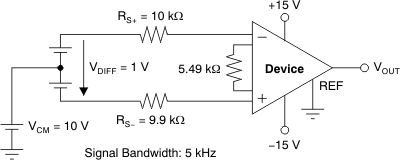SBOS562G August 2011 – June 2020 INA826
PRODUCTION DATA.
- 1 Features
- 2 Applications
- 3 Description
- 4 Revision History
- 5 Device Comparison Table
- 6 Pin Configuration and Functions
- 7 Specifications
-
8 Detailed Description
- 8.1 Overview
- 8.2 Functional Block Diagram
- 8.3 Feature Description
- 8.4 Device Functional Modes
- 9 Application and Implementation
- 10Power Supply Recommendations
- 11Layout
- 12Device and Documentation Support
- 13Mechanical, Packaging, and Orderable Information
封装选项
机械数据 (封装 | 引脚)
散热焊盘机械数据 (封装 | 引脚)
- DRG|8
订购信息
8.3.10 Error Sources
Most modern signal-conditioning systems calibrate errors at room temperature. However, calibration of errors that result from a change in temperature is normally difficult and costly. Therefore, minimizing these errors is important. Make sure to choose high-precision components, such as the INA826, that have improved specifications in critical areas that impact the precision of the overall system. Figure 62 shows an example application.
 Figure 62. Example Application With G = 10 V/V and 1-V Differential Voltage
Figure 62. Example Application With G = 10 V/V and 1-V Differential Voltage Resistor-adjustable INAs, such as the INA826, show the lowest gain error in G = 1 because of the inherently well-matched drift of the internal resistors of the differential amplifier. At gains greater than 1 (for instance, G = 10 V/V or G = 100 V/V), the gain error becomes a significant error source because of the contribution of the resistor drift of the 24.7-kΩ feedback resistors in conjunction with the external gain resistor. Except for very high gain applications, the gain drift is by far the largest error contributor compared to other drift errors, such as offset drift.
The INA826 offers excellent gain error over temperature for both G > 1 and G = 1 (no external gain resistor). Table 2 summarizes the major error sources in common INA applications and compares the two cases of G = 1 (no external resistor) and G = 10 (5.49-kΩ external resistor). As can be seen in Table 2, although the static errors (absolute accuracy errors) in G = 1 are almost twice as great as compared to G = 10, there are much fewer drift errors because of the much lower gain error drift. In most applications, these static errors can readily be removed during calibration in production. All calculations refer the error to the input for easy comparison and system evaluation.
Table 2. Error Calculations
| ERROR SOURCE | ERROR CALCULATION | INA826 | ||
|---|---|---|---|---|
| SPECIFICATION | G = 10 ERROR (ppm) | G = 1 ERROR (ppm) | ||
| ABSOLUTE ACCURACY AT 25°C | ||||
| Input offset voltage (µV) | VOSI / VDIFF | 150 | 150 | 150 |
| Output offset voltage (µV) | VOSO / (G × VDIFF) | 700 | 70 | 700 |
| Input offset current (nA) | IOS × maximum (RS+, RS–) / VDIFF | 5 | 50 | 50 |
| CMRR (dB) | VCM / (10CMRR/20 × VDIFF) | 104 (G = 10),
84 (G = 1) |
63 | 631 |
| Total absolute accuracy error (ppm) | 333 | 1531 | ||
| DRIFT TO 105°C | ||||
| Gain drift (ppm/°C) | GTC × (TA – 25) | 35 (G = 10),
1 (G = 1) |
2800 | 80 |
| Input offset voltage drift (µV/°C) | (VOSI_TC / VDIFF) × (TA – 25) | 2 | 160 | 160 |
| Output offset voltage drift (µV/°C) | [VOSO_TC / ( G × VDIFF)] × (TA – 25) | 10 | 80 | 800 |
| Offset current drift (pA/°C) | IOS_TC × maximum (RS+, RS–) ×
(TA – 25) / VDIFF |
60 | 48 | 48 |
| Total drift error (ppm) | 3088 | 1088 | ||
| RESOLUTION | ||||
| Gain nonlinearity (ppm of FS) | 5 | 5 | 5 | |
| Voltage noise (1 kHz) |  |
eNI = 18,
eNO = 110 |
10 | 10 |
| Total resolution error (ppm) | 15 | 15 | ||
| TOTAL ERROR | ||||
| Total error | Total error = sum of all error sources | 3436 | 2634 | |